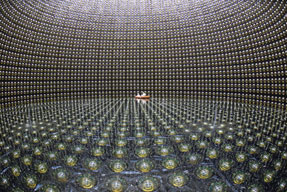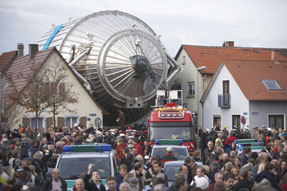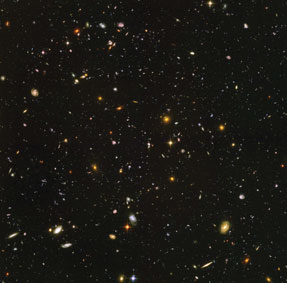Life
The Mystery Of The Ghost Particles

The most abundant fundamental particles are paradoxically the most elusive.
| They enter everywhere, unnoticed and strike at the heart of everything, without anyone realizing it. They have been traveling since the birth of the universe. They zip through the earth and continue their voyage, a journey that began long before the solar system was in place. Like a ghost, they are undetectable and disguise their identity. They act like a chameleon and morph when we try to catch them. As you read this, billions of them entered and exited through your body.
Enter the world of neutrinos — the improbable invisible particles. As much as they are abundant, paradoxically, they are hard to detect. It is no surprise that researchers call them the Ghost Particles. While their better-named cousins God Particles (Higgs Boson) remain still theoretical and not yet found, the neutrinos are everywhere. Some researchers even believe these particles account for the missing mass of the universe — oddly termed as dark matter. Neutrinos are the second most plentiful particles in the universe, just behind photons, the particles that make up light. They come in different flavors and on their way to earth they switch their identity, compounding the mystery that surrounds them. “Every second, hundreds of billions of these neutrinos pass through each square inch of our bodies, coming from above during the day and from below at night, when the sun is shining on the other side of the earth!” wrote M.A. Ruderman and A.H. Rosenfeld in American Scientist.
Neutrinos are little neutrons, the chargeless particles inside atoms. These tiny neutrons do not reside inside the atom like their bigger partner; instead they pass through all material objects as if they weren’t present. While neutrons posses mass that makes up the atom, neutrinos are considered massless, at least, until recently. These strange characteristics enable them not to interact with anything they encounter, and the consequence is that nothing can catch or trap them. They truly live up to their name — Ghost Particles. These particles were introduced to modern physics in 1930 by Wolfgang Pauli, who invented these hypothetical particles in an effort to save the law of conservation of energy, a fundamental law in the universe. The observations of beta decay in radioactive materials demanded that a particle like neutrino must exist so that this law is not violated. Neutrinos come from several sources. Most of them were created during the first few moments after the big bang. The 14-billion-year journey exhausted them and they remain mostly undetectable. But, they, along with microwave radiation, create the Cosmic Background Radiation, the picture of the infant universe. Other types of neutrinos are produced in exploding stars as well as in laboratory experiments, such as particle accelerators. Cosmic rays, coming from various stellar phenomena that bombard the Earth perpetually, are also comprised of neutrinos along with other particles.
The sun is also a source of neutrinos, which are known as solar neutrinos. In the core of our sun four protons combine with two electrons to form a helium nucleus, and in that process two electron neutrinos are created. A daring experiment spanning several years in a deep South Dakota mine allowed us to observe the solar neutrinos. Late Raymond Davis and his colleagues built a tank of 100,000 gallons of cleaning fluid in the depth of the mine to capture the solar neutrinos. Of the billions and billions of these particles coming from the sun one would hit an atom of the fluid on a day on average. Raymond Davis was awarded the Nobel Prize for discovering solar neutrinos through this painstaking experiment. Neutrinos, like the ones coming from the sun, can go through an average 10,000 light-years of lead before interacting once. Although this was an expected behavior, given the strange properties of these elusive particles, surprisingly a huge disparity existed between the number of neutrinos that arrive on earth from sun and the numbers calculated theoretically that are created in the sun. In the standard model of fundamental particles, this has come to be known as “The Mystery of the Missing Neutrinos” and baffled researchers for a long time. The two possible explanations were either that our understanding of the working of sun is incorrect or the theoretical calculations of their numbers are erroneous.
However, a recent experiment has provided an explanation for the “missing neutrinos,” although it contributed another dimension to their mystery. Physicists at the Gran Sasso Laboratory in central Italy have been monitoring billions of muon neutrinos beamed to them through earth from the CERN Laboratory in Geneva, 456 miles away. They had confirmed that a muonneutrino turned into a tau neutrino in an obvious sign of switching identity by a fundamental particle on its way to its destination. Apparently, this could explain why there are fewer numbers of neutrinos arriving on earth than one expects. This long-sought proof suggests that other type of neutrinos could exist and slip detection. The solar neutrinos on their way to earth transform to other kinds of neutrinos that we do not yet know. The personality disorder exhibited by neutrinos that enables them to switch their identity once again underlines the never-ending wonders of the cosmos and the human limitations of comprehending it. “Neutrinos may be able to tell us things that the more humdrum particles can’t,” says Boris Kayser, a theoretical physicist at Fermilab in Batavia, Ill.
The ability of neutrinos to transform demands that they must have mass to jump between different flavors, a major deviation from the earlier understanding that these particles are massless. The question of their mass has cosmic importance. For a very long time, it was assumed that neutrinos are massless. However, the new experiments suggest that they could have a tiny bit of mass, maybe even less than that of an electron. Since they are created in vast quantities the tiny masses could become a significant quantity. Astronomers are unsure what 90% of the universe is made of and if the mass of neutrinos could provide part of the answer, then dark matter will not be so dark. At this point, no such definite conclusion is possible. Researchers are relying on upcoming experiments and detection for clarity. Neutrino detectors are located underground to avoid other particles that could create spurious results. One of the detectors is at the Sudbury Neutrino Observatory (SNO) situated two kilometers underground at the Creighton Mine in Ontario, Canada. Physicists think that neutrinos, as demonstrated in the CERN experiment, can switch identities between three known types — electron neutrino, muon neutrino and tau neutrino — and SNO will be able to detect all three kinds. Are there undiscovered particles and laws of nature? In the quest to understand the fundamental nature of the universe, physicists have modeled a universe with so-called elementary particles that make up everything. But as they explore closely, the secret life of fundamental particles is unveiling a nature of reality beyond our imagination.
While the mysteries about these particles persist, some researchers are considering the practical applications of neutrinos. As we know, underwater communication, such as for submarines, is in its infancy even now. Radio waves, our most common tool of communication, do not travel well in water restricting underwater communication rates to a few bytes per second. Since neutrinos can travel through any material including water almost at the speed of light, researchers see a potential in new forms of underwater communication using these particles. The ghost particles might one day become a tool of communication considered hitherto impossible. The enthusiasm about neutrino research is so widespread that many researchers are joining the particle hunt adventure. Recently, the Indian Government gave clearance to the Department of Atomic Energy to set up a neutrino observatory. This facility will be completed in Bodi West Hills Reserved Forest in Theni district in south Tamil Nadu. The underground lab will be used to detect and study earth penetrating neutrinos.. These most un-interactive particles can liberate our imaginations, and are capable of revealing the hidden places in the cosmos. The star explosions like supernova emit huge amount of neutrinos, providing the opportunity for studying the core of the stars and their inner dynamics. As these particles pass through intervening matter, they can provide us a magic vision of the cosmos, if we can catch them. Among the numerous particles that make up our universe, neutrinos are the tiniest and mostly sterile, yet their implications are profound. A coherent theory of fundamental reality has to account for the mysteries of these ghost particles.
|







You must be logged in to post a comment Login